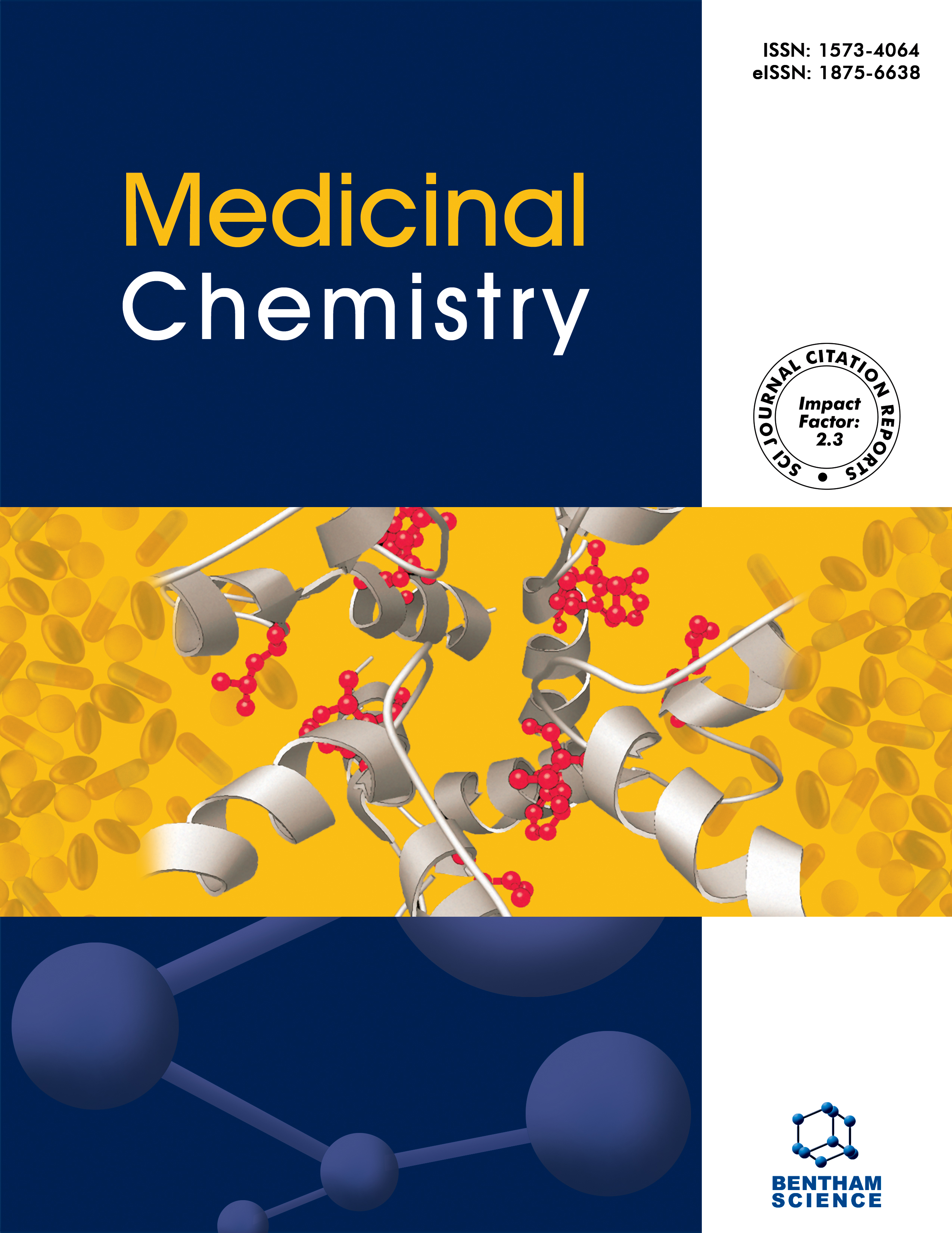- Home
- A-Z Publications
- Medicinal Chemistry
- Previous Issues
- Volume 19, Issue 10, 2023
Medicinal Chemistry - Volume 19, Issue 10, 2023
Volume 19, Issue 10, 2023
-
-
Calixarenes and their Relevance in Anticancer Drug Development
More LessCalixarenes have always captured the attention of several researchers. They have the ability to entrap multiple molecules and form inclusion complexes with drugs due to their unique structure. Due to this property, they are being widely used in the development of several classes of drugs, most notably anticancer drugs. This review attempted to summarize the potential applications of calixarenes and its derivatives i Read More
-
-
-
A Unique Perspective on Lead Compounds for Dementia with the Lewy Body
More LessDementia with Lewy Bodies is a neurodegenerative disorder characterised by abnormal α- synuclein aggregate accumulation in Lewy Bodies and Lewy Neurites and the most common form of dementia after Alzheimer’s disease. The presynaptic protein alpha-synuclein (α-Syn) regulates synaptic vesicle trafficking and the subsequent release of neurotransmitters in the brain. These aggregates go through a number of cru Read More
-
-
-
An Explicative Review on the Current Advancement in Schiff Base-Metal Complexes as Anticancer Agents Evolved in the Past Decade: Medicinal Chemistry Aspects
More LessAuthors: Dipanjan Karati, Swarupananda Mukherjee and Souvik RoyIn the recent era, developments in the field of bio-inorganic chemistry have improved interest in Schiff base complexes (imine scaffolds) for their pharmacological excellence in different areas. Schiff bases are a kind of synthetic molecule that is synthesized by the condensation reaction between a 1o amine and a carbonyl compound. Imine derivatives are also acknowledged for their ability to form complexes with several Read More
-
-
-
Identification of Non-steroidal Aromatase Inhibitors via In silico and In vitro Studies
More LessIntroduction: Breast cancer is the most common cancer affecting women worldwide, including Pakistan. More than half of breast cancer patients have hormone-dependent breast cancer, which is developed due to the over-production of estrogen (the main hormone in breast cancer). Methods: The biosynthesis of estrogen is catalyzed by the aromatase enzyme, which thus serves as a target for the treatment of breast Read More
-
-
-
In silico Prediction of ADMET/Drug-likeness Properties of Bioactive Phloroglucinols from Hypericum Genus
More LessBackground: Dimeric acylphloroglucinols occurring in species from sections Brathys and Trigynobrathys of the genus Hypericum exhibit acylfilicinic acid and acylphloroglucinol moieties linked by a methylene bridge. However, this chemical feature differs from hyperforin, from H. perforatum (Hypericum section). Some dimeric acylphloroglucinols, such as uliginosin B, display similar pharmacological activities, namely antidepre Read More
-
-
-
Design, Synthesis, in silico and in vitro Evaluation of New Combretastatin A-4 Analogs as Antimitotic Antitumor Agents
More LessAuthors: Shaker A. Abdul Hussein, Ammar Kubba, Asim A. Balakit, Lubna H. Tahtamouni and Ali H. AbbasBackground: Combretastatin A-4 (CA-4) binds β-tubulin at the colchicine-binding site preventing tubulin from polymerizing into microtubules. CA-4 and cis combretastatin analogs isomerize to the trans form resulting in decreased cytotoxicity and anti-tubulin activity. However, the excellent anti-cancer potential and relatively simple molecular structure of CA-4 provide an encouraging starting point for the development of new, m Read More
-
-
-
Development of Dual Inhibitors of Soluble Epoxide Hydrolase/Fatty Acid Amide Hydrolase with Tetrazole Core
More LessAuthors: Sara Mehrandish, Elham Rezaee, Anna Sedaghat, Elmira Heidarli, Nima Naderi and Sayyed A. TabatabaiIntroduction: The attractive biological actions of the eicosatrienoic acids (EETs) and endocannabinoids (eCBs) are terminated by means of enzymatic hydrolysis via soluble epoxide hydrolase (sEH) and fatty acid amide hydrolase (FAAH) enzymes. Simultaneous inhibition of both enzymes is considered a novel approach in the treatment of inflammatory and neuropathic pain. Methods: In this study, a novel series of tetrazol Read More
-
-
-
Ligand-Based and Structure-Based Virtual Screening of New Sodium Glucose Cotransporter Type 2 Inhibitors
More LessBackground: Diabetes mellitus is a metabolic disease that causes multiple complications and common comorbidities, which decreases the quality of life for people affected by the disease. Sodium glucose cotransporter type 2 (SGLT2) participates in the reabsorption of 90% of glucose in the kidneys; therefore, it is an attractive drug target for controlling blood glucose levels. Objective: The aim in this work was to obtain new p Read More
-
Volumes & issues
-
Volume 21 (2025)
-
Volume 20 (2024)
-
Volume 19 (2023)
-
Volume 18 (2022)
-
Volume 17 (2021)
-
Volume 16 (2020)
-
Volume 15 (2019)
-
Volume 14 (2018)
-
Volume 13 (2017)
-
Volume 12 (2016)
-
Volume 11 (2015)
-
Volume 10 (2014)
-
Volume 9 (2013)
-
Volume 8 (2012)
-
Volume 7 (2011)
-
Volume 6 (2010)
-
Volume 5 (2009)
-
Volume 4 (2008)
-
Volume 3 (2007)
-
Volume 2 (2006)
-
Volume 1 (2005)
Most Read This Month
Article
content/journals/mc
Journal
10
5
false
en


